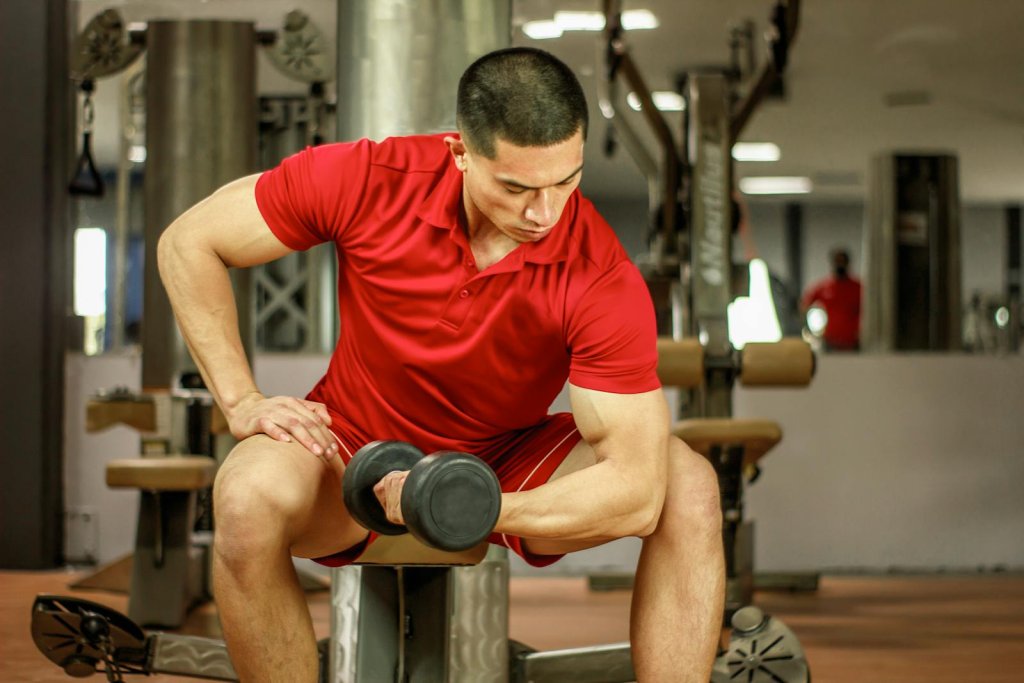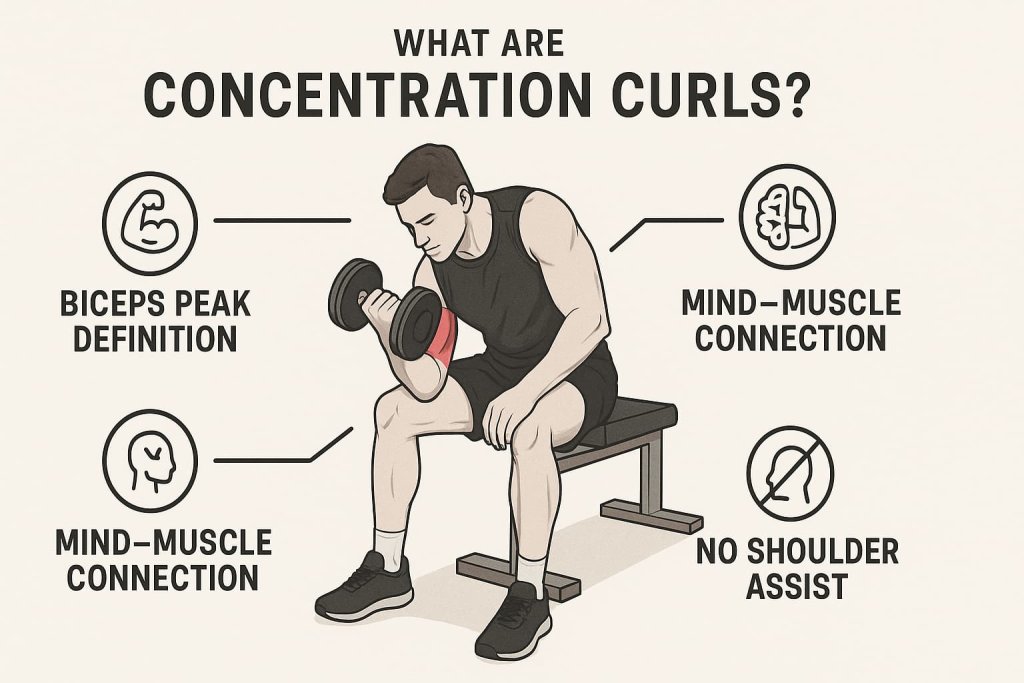Most lifters do concentration curls wrong—using momentum, poor elbow placement, and limited range of motion—and that’s why their biceps aren’t growing as much as they could. By fixing your form, you can maximize muscle activation and finally achieve that defined biceps peak.

Concentration curls are a staple for isolating the biceps, but without proper technique, the benefits drop drastically. This guide explains the most common mistakes, how to correct them, the muscles worked, variations, and pro tips from trainers—so your next arm day delivers real results.
What Are Concentration Curls?
Concentration curls are a seated, single-arm dumbbell curl variation where you brace the back of your upper arm against the inside of your thigh. The setup eliminates body sway, keeps your elbow fixed in place, and forces your biceps to do all the lifting.

They’re particularly effective for:
- Improving biceps definition (especially the peak)
- Enhancing mind–muscle connection
- Reducing assistance from shoulders or back
Why it works: By limiting movement in your shoulder joint and locking your upper arm, you remove most cheating opportunities. This isolates the biceps brachii and allows for focused, controlled contractions.
Common Mistakes (and Why They Kill Your Gains)
1. Using Momentum Instead of Muscle
What happens: You swing the dumbbell upward, using hips, shoulders, or back to help lift.
Why it’s bad: Momentum takes tension away from the biceps, reducing time under tension—a key driver for muscle growth.
Real example: If you can curl the weight only by jerking your torso forward, you’re working your lower back more than your arms.
2. Incorrect Elbow Placement
What happens: Resting your elbow joint directly on your thigh bone.
Why it’s bad: This turns the movement into a leverage game instead of muscle contraction, and it can strain the elbow joint.
Fix: Place the back of your upper arm (triceps) against your inner thigh. This allows for stability without joint compression.
3. Cutting the Range of Motion Short
What happens: You start halfway up or stop before full contraction.
Why it’s bad: The biceps never get fully lengthened or shortened, which reduces activation of all muscle fibers.
Example: Dropping the weight halfway down misses the muscle stretch needed for optimal hypertrophy.
4. Poor Posture and Core Engagement
What happens: Rounding your back or leaning excessively to one side.
Why it’s bad: This shifts tension to other muscles and increases injury risk.
Solution: Keep your chest up, shoulders back, and core braced throughout the set.
Step-by-Step: How to Do Concentration Curls Properly
1. Setup
- Sit on the edge of a flat bench with feet firmly on the ground.
- Hold a dumbbell in one hand, letting it hang toward the floor.
- Slightly lean forward, keeping your spine neutral.
2. Arm Position
- Place the back of your upper arm (not the elbow) against the inside of your thigh.
- Keep your elbow directly below your shoulder.
3. Curl Execution
- Rotate your palm upward as you curl the dumbbell toward your shoulder.
- Keep your upper arm still—only your forearm should move.
- At the top, squeeze your biceps hard for 1–2 seconds.
4. Eccentric Phase
- Lower the weight slowly (3–4 seconds) until your arm is fully extended.
- Avoid letting the dumbbell rest at the bottom between reps.
Muscles Worked
- Primary: Biceps brachii (long and short heads)
- Secondary: Brachialis, brachioradialis (forearms)
Because your shoulder and back remain static, the concentration curl maximizes biceps isolation better than most curl variations.
Trainer Tips for Better Results
- Control the tempo – 2 seconds up, 3–4 seconds down.
- Lighten the load – Choose a weight you can curl cleanly for 10–12 reps without swinging.
- Use mind–muscle connection – Visualize your biceps contracting.
- Train both arms equally – Start with your weaker arm to prevent imbalance.
Benefits of Doing Concentration Curls Correctly
- Maximized Biceps Isolation – Reduces shoulder and back involvement.
- Better Peak Development – Targets the long head of the biceps.
- Improved Muscle Control – Teaches strict curling form.
- Safer on Joints – Encourages lighter, more controlled lifting.
Effective Variations
- Standing Concentration Curl – Increases core involvement.
- Cable Concentration Curl – Provides constant tension from start to finish.
- Incline Concentration Curl – Offers a greater stretch at the bottom position.
Common Questions Answered
Q1: Should I go heavy on concentration curls?
No. This is a strict isolation move—moderate weight with perfect form is more effective than heavy weight with sloppy reps.
Q2: Are they better than barbell curls for size?
They’re better for definition and isolation but won’t match the mass-building potential of heavy compound curls.
Q3: Can I do them every arm workout?
Yes, but limit to 3–4 sets per session to avoid overtraining.
Q4: Should I lock my elbow?
No—keep it fixed in place but not locked out rigidly.
Q5: Can beginners do concentration curls?
Absolutely—just start with light weight and prioritize form.
Workout Programming
- Sets/Reps: 3–4 sets of 10–12 reps per arm.
- Rest: 45–60 seconds between sets.
- Placement: Best performed after compound curls like barbell curls or chin-ups.
Conclusion
If you’ve been swinging your dumbbell, placing your elbow wrong, or rushing reps, you’ve been shortchanging your biceps. Concentration curls require patience, control, and precision. By correcting your form, focusing on the squeeze, and using a full range of motion, you’ll unlock their true potential—helping you build the peak and definition you’ve been chasing.
